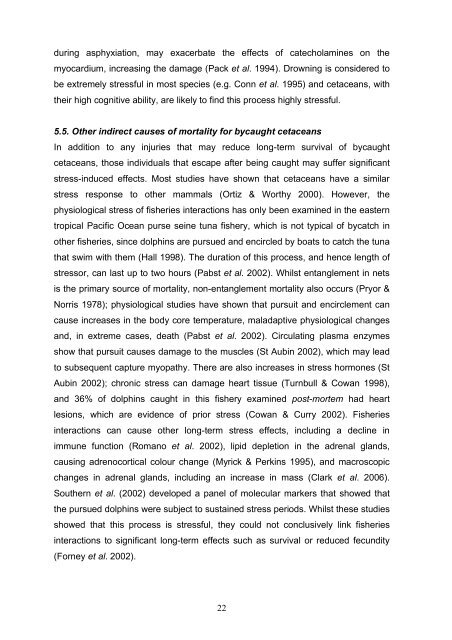The Animal Welfare Implications of Cetacean Deaths in Fisheries
The Animal Welfare Implications of Cetacean Deaths in Fisheries
The Animal Welfare Implications of Cetacean Deaths in Fisheries
Create successful ePaper yourself
Turn your PDF publications into a flip-book with our unique Google optimized e-Paper software.
dur<strong>in</strong>g asphyxiation, may exacerbate the effects <strong>of</strong> catecholam<strong>in</strong>es on the<br />
myocardium, <strong>in</strong>creas<strong>in</strong>g the damage (Pack et al. 1994). Drown<strong>in</strong>g is considered to<br />
be extremely stressful <strong>in</strong> most species (e.g. Conn et al. 1995) and cetaceans, with<br />
their high cognitive ability, are likely to f<strong>in</strong>d this process highly stressful.<br />
5.5. Other <strong>in</strong>direct causes <strong>of</strong> mortality for bycaught cetaceans<br />
In addition to any <strong>in</strong>juries that may reduce long-term survival <strong>of</strong> bycaught<br />
cetaceans, those <strong>in</strong>dividuals that escape after be<strong>in</strong>g caught may suffer significant<br />
stress-<strong>in</strong>duced effects. Most studies have shown that cetaceans have a similar<br />
stress response to other mammals (Ortiz & Worthy 2000). However, the<br />
physiological stress <strong>of</strong> fisheries <strong>in</strong>teractions has only been exam<strong>in</strong>ed <strong>in</strong> the eastern<br />
tropical Pacific Ocean purse se<strong>in</strong>e tuna fishery, which is not typical <strong>of</strong> bycatch <strong>in</strong><br />
other fisheries, s<strong>in</strong>ce dolph<strong>in</strong>s are pursued and encircled by boats to catch the tuna<br />
that swim with them (Hall 1998). <strong>The</strong> duration <strong>of</strong> this process, and hence length <strong>of</strong><br />
stressor, can last up to two hours (Pabst et al. 2002). Whilst entanglement <strong>in</strong> nets<br />
is the primary source <strong>of</strong> mortality, non-entanglement mortality also occurs (Pryor &<br />
Norris 1978); physiological studies have shown that pursuit and encirclement can<br />
cause <strong>in</strong>creases <strong>in</strong> the body core temperature, maladaptive physiological changes<br />
and, <strong>in</strong> extreme cases, death (Pabst et al. 2002). Circulat<strong>in</strong>g plasma enzymes<br />
show that pursuit causes damage to the muscles (St Aub<strong>in</strong> 2002), which may lead<br />
to subsequent capture myopathy. <strong>The</strong>re are also <strong>in</strong>creases <strong>in</strong> stress hormones (St<br />
Aub<strong>in</strong> 2002); chronic stress can damage heart tissue (Turnbull & Cowan 1998),<br />
and 36% <strong>of</strong> dolph<strong>in</strong>s caught <strong>in</strong> this fishery exam<strong>in</strong>ed post-mortem had heart<br />
lesions, which are evidence <strong>of</strong> prior stress (Cowan & Curry 2002). <strong>Fisheries</strong><br />
<strong>in</strong>teractions can cause other long-term stress effects, <strong>in</strong>clud<strong>in</strong>g a decl<strong>in</strong>e <strong>in</strong><br />
immune function (Romano et al. 2002), lipid depletion <strong>in</strong> the adrenal glands,<br />
caus<strong>in</strong>g adrenocortical colour change (Myrick & Perk<strong>in</strong>s 1995), and macroscopic<br />
changes <strong>in</strong> adrenal glands, <strong>in</strong>clud<strong>in</strong>g an <strong>in</strong>crease <strong>in</strong> mass (Clark et al. 2006).<br />
Southern et al. (2002) developed a panel <strong>of</strong> molecular markers that showed that<br />
the pursued dolph<strong>in</strong>s were subject to susta<strong>in</strong>ed stress periods. Whilst these studies<br />
showed that this process is stressful, they could not conclusively l<strong>in</strong>k fisheries<br />
<strong>in</strong>teractions to significant long-term effects such as survival or reduced fecundity<br />
(Forney et al. 2002).<br />
22
















